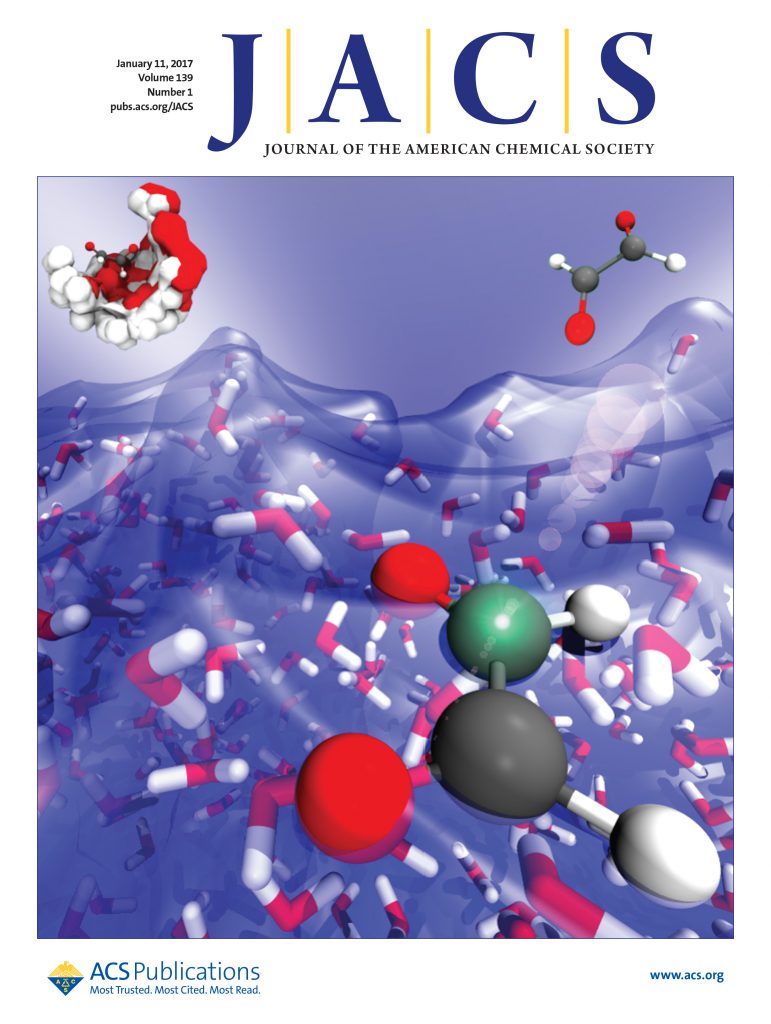The Electronic Structure of the Superatom Au3.
IF 15.6
1区 化学
Q1 CHEMISTRY, MULTIDISCIPLINARY
引用次数: 0
Abstract
At the heart of large gold clusters lies Au3+, a key three-ring structure that plays a fundamental role in many gold assemblies. Studying this smallest unit provides valuable insight into the photocatalytic mechanisms of larger gold systems. This study presents the first high-resolution, vibrationally resolved optical spectra of mass-selected Au3+ clusters obtained through photodissociation spectroscopy. The spectra, spanning 2.7-5.0 eV, reveal five band systems with complex and irregular structures. To interpret these spectra, we employ ab initio calculations at the CASSCF level, incorporating spin-orbit coupling to characterize the electronic structure of Au3+. These calculations reveal that the observed spectral features arise from the interplay of closely spaced excited states dominated by d-orbital excitations, a small s-d orbital gap, and significant vibronic and spin-orbit coupling. Our findings emphasize that accurate characterization of the excited states of Au3+, a seemingly simple triatomic molecule with a valence configuration and orbital structure similar to that of the strontium atom, requires sophisticated multireference calculations. Simplified theoretical methods, such as density functional theory (DFT) and those utilizing small HOMO-LUMO active spaces, fail to capture the strong multireference effects driven by d-orbital contributions, underscoring the complexity of excited-state interactions in gold clusters.超原子Au3的电子结构。
大型金团簇的核心是Au3+,这是一种关键的三环结构,在许多金团簇中起着重要作用。研究这个最小的单位为更大的金系统的光催化机制提供了有价值的见解。本研究首次通过光解光谱获得了大量选择的Au3+团簇的高分辨率、振动分辨光谱。光谱范围在2.7 ~ 5.0 eV之间,显示出结构复杂、不规则的五波段体系。为了解释这些光谱,我们在CASSCF水平上采用从头计算,结合自旋轨道耦合来表征Au3+的电子结构。这些计算表明,观测到的光谱特征来自于以d轨道激励为主的密集激发态的相互作用,小的s-d轨道间隙,以及显著的振动和自旋轨道耦合。我们的研究结果强调,Au3+是一种看似简单的三原子分子,其价态和轨道结构与锶原子相似,要准确表征其激发态,需要复杂的多参考计算。简化的理论方法,如密度泛函数理论(DFT)和利用小HOMO-LUMO活动空间的理论方法,无法捕获由d轨道贡献驱动的强多参考效应,强调了金团簇中激发态相互作用的复杂性。
本文章由计算机程序翻译,如有差异,请以英文原文为准。
求助全文
约1分钟内获得全文
求助全文
来源期刊
CiteScore
24.40
自引率
6.00%
发文量
2398
审稿时长
1.6 months
期刊介绍:
The flagship journal of the American Chemical Society, known as the Journal of the American Chemical Society (JACS), has been a prestigious publication since its establishment in 1879. It holds a preeminent position in the field of chemistry and related interdisciplinary sciences. JACS is committed to disseminating cutting-edge research papers, covering a wide range of topics, and encompasses approximately 19,000 pages of Articles, Communications, and Perspectives annually. With a weekly publication frequency, JACS plays a vital role in advancing the field of chemistry by providing essential research.

 求助内容:
求助内容: 应助结果提醒方式:
应助结果提醒方式:


